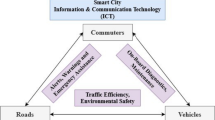Abstract
The draft document of the new IEEE 802.15.4e specification assumes receiver initiated transmission (RIT) to reduce energy consumption of wireless sensors by turning off the radio periodically, even if they operate in mesh topology. The original contribution from this paper is developing and evaluating the RIT strategies intended for street lighting systems using wireless sensor networks to control and monitor public lighting systems. This paper presents a new configuration strategies for the RIT mechanism based on mapping weights assigned to devices when routing the gradient, which provides better performance when compared to the energy consumed by the network, average end-to-end delay and end-to-end delivery rate. The experiments were performed using the simulation tool ns-2. Results show that the developed strategies make the use of RIT in urban networks feasible, according to the requirements specified in RFC 5548.













Similar content being viewed by others
References
RFC 5548. “Routing Requirements for Urban Low-Power and Lossy Networks”. Available at: <http://datatracker.ietf.org/doc/rfc5548.txt>. Accessed on: July 30, 2010.
IEEE 802.15.4 Draft Rev 05. IEEE Std 802.15.4e-D0.01/r5: IEEE Draft Standard for Information Technology - Telecommunications and Information Exchange Between Systems - Local and Metropolitan Area Networks - Specific Requirements - Part 15.4: Wireless Medium Access Control (MAC) and Physical Layer (PHY) Specifications for Low Rate Wireless Personal Area Networks (WPANs), IEEE Computer Society, IEEE Unapproved Draft Std 802.15.4e-D0.01, 2010.
IEEE 802.15 WPAN TASK GROUP 4E. Available at: <http://www.ieee802.org/15/pub/TG4e.html>. Accessed on: April 02, 2012.
M. M. Monowar, M. M. Alam, O. Rahman, C. S. Hong and S. Lee, A load-aware energy-efficient and throughput-maximized asynchronous duty cycle MAC for wireless sensor networks, Annals of Telecommunications, Vol. 65, No. 11–12, pp. 777–794, 2010.
Sun, Y.; Gurewitz, O.; Johnson, D. B. “RI-MAC: A Receiver-Initiated Asynchronous Duty Cycle MAC Protocol for Dynamic Traffic Loads in Wireless Sensor Networks”. Proceedings of Conference On Embedded Networked Sensor Systems - SENSYS, Raleigh, USA, 2008, p. 1-14.
Dutta, P; Dawson-Haggerty, S; Chen, Y.; Liang, C-J. M.; Terzis, A. “Design and Evaluation of a Versatile and Efficient Receiver-Initiated Link Layer for Low-Power Wireless”. Proceedings of Conference On Embedded Networked Sensor Systems - SENSYS, Zurich, Switzerland, 2010, p. 1-14.
Yang, G.Z. (2006). Body sensor networks. Springer. 528 p.
Li, J; Zhang, D.; Guo, L; Ji, S. Li, Y. “ARM: an Asynchronous Receiver-initiated Multichannel MAC Protocol with Duty Cycling for WSNs”. Proceedings of The 29th Ieee International Performance Computing And Communications Conference (IPCCC 2010), Albuquerque, NM, 2010.
MC1321X. Freescale Semiconductor Technical Data for MC1321x Rev. 1.8 08/2009. Technical specification for device. 2008. 70 p.
Jennic. Calculating data rates in an IEEE 802.15.4-based network. Application Note, 2006. Available at: <http://www.jennic.com/support/application_notes/jn-an-1035_calculating_data_rates_in_an_ieee_802154-based_network>. Accessed on: April 2011.
NS2. Available at: <http://www.isi.edu/nsnam/ns>. March, 2012
K. L. Blackard, T. S. Rappaport and C. W. Bostian, Measurements and models of radio frequency impulsive noise for indoor wireless communications, IEEE Journal on Selected Areas in Communications, Vol. 11, pp. 991–1001, 1993.
Giordano, E; Frank, R.; Pau, Giovanni; Gerla, M. “CORNER: A Radio Propagation Model for VANETs in Urban Scenarios”. Proceedings of the IEEE, v. 99, n. 7, p. 1280- 1294, 2011.
V. Sridhar and S. Bohacek, Realistic propagation simulation of urban mesh networks, Computer Networks, Vol. 51, No. 12, pp. 3392–3412, 2007.
A. Andreadis, Giambene, SpringerG. Protocols for high-efficiency wireless networks, 2002. pp. 284.
Feng, Q.; Mcgeehan, J.; Tameh,E.K.; Nix, A.R. “Path Loss Models for Air-to-Ground Radio Channels in Urban Environments”. Proceedings of IEEE Vehicular Technology Conference, Melbourne, USA, 2006.
Srinivasan, K.; Levis, P. “RSSI is under appreciated”. Proceedings of Workshop On Embedded Networked Sensors, Cambridge, MA, 2006.
Faheem, A.; Virrankoski, R.; Elmusrati, M. Improving RSSI based distance estimation for 802.15.4 wireless sensor networks. Proceedings of IEEE International Conference On Wireless Information Technology, Honolulu, HI, 2010.
P. Bhagwat, P. Bhattacharya, A. Krishna and S. K. Tripathi, Using channel state dependent packet scheduling to improve tcp throughput over wireless LANs, Wireless Networks, Vol. 3, No. 1, pp. 91–102, 1997.
Pantoni, R.P.; Brandao, D. “Confirmation-Based Routing For Convergent Traffic Intended for Urban Networks”. Proceedings of IEEE International Conference on Industrial Technology, Athens, Greece, 2012.
Google Maps API Family. Available at: <http://code.google.com/intl/en/apis/maps/>. Accessed on: March 2011.
Faruque, J.; Psounis, K.; Helmy, A. “Analysis of Gradient-based Routing Protocols in Sensor Networks”. Proceedings of IEEE International Conference Distributed Computing In Sensor Systems. Marina del Rey, CA, USA.
Lin,C.-H.; Yuan,S.-A.; Chiu,S.W.; Tsai, M.J. (2010). ProgressFace: An Algorithm to Improve Routing Efficiency of GPSR-Like Routing Protocols in Wireless Ad Hoc Networks. IEEE Transactions on Computers, v. 59, n. 6, Jun. 2010.
Author information
Authors and Affiliations
Corresponding author
Rights and permissions
About this article
Cite this article
Pantoni, R.P., Brandão, D. Receiver Initiated Transmission Strategies Applied to Street Lighting Systems Based on Wireless Sensor Networks. Int J Wireless Inf Networks 22, 126–137 (2015). https://doi.org/10.1007/s10776-015-0266-z
Received:
Accepted:
Published:
Issue Date:
DOI: https://doi.org/10.1007/s10776-015-0266-z




